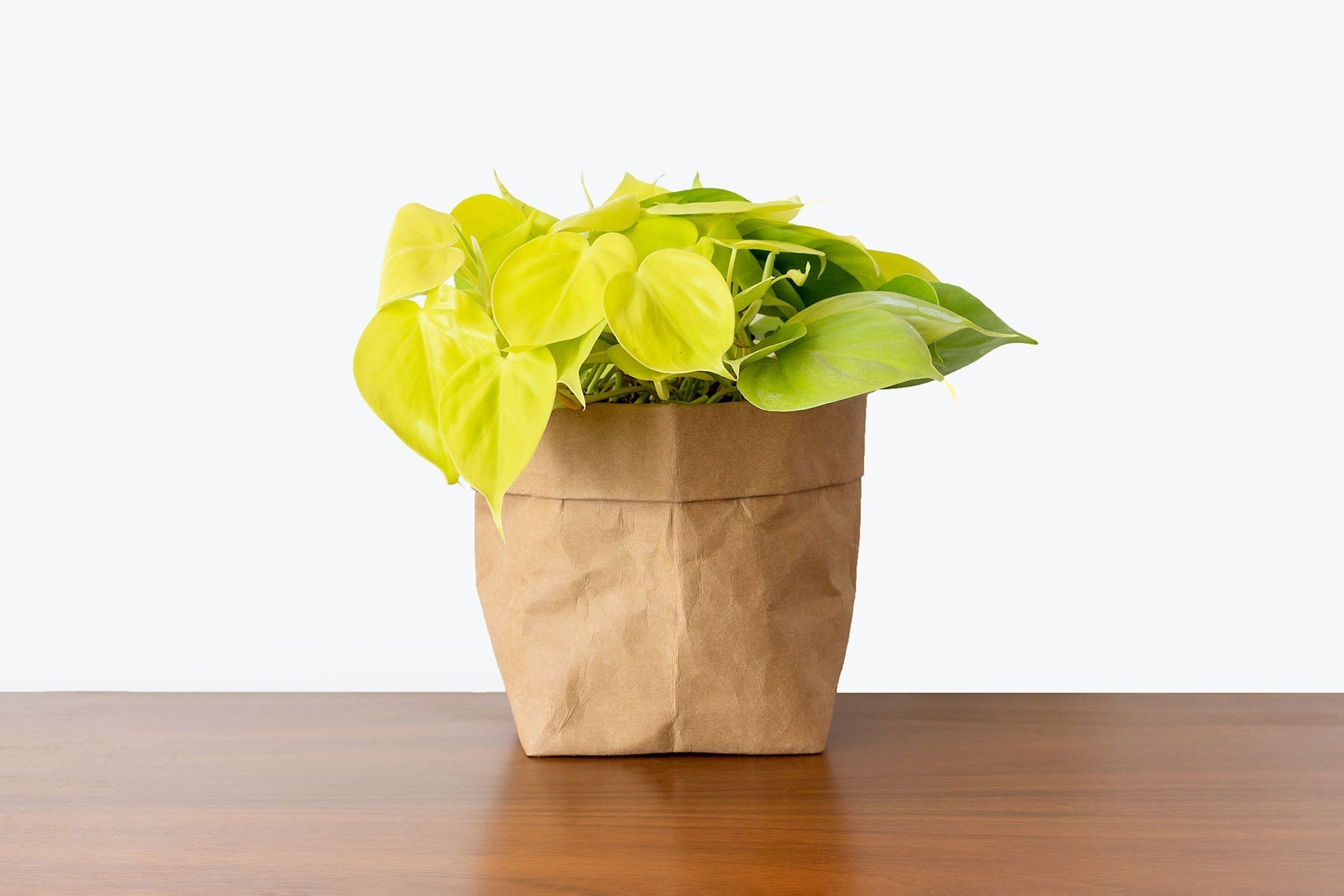
Plant Breakdown: The Difference Between Heartleaf Philodendron Species
In our opinion, one of the most classic of houseplants is the Philodendron hederaceum, or Heartleaf Philodendron. We can almost guarantee that you will find one of these beauties in either your mom's or grandma's house, or any house for that matter, with long, trailing stems of stunning, deep green, heart-shaped, delightfully soft leaves. Thriving in most light levels and only needing to be watered when the soil is just about dry, it's no wonder why they are such a staple. The ease of their care and low maintenance routine makes them incredibly attractive to any plant parent, or future plant parent.
Native to Central America and the Caribbean, the Philodendron hederaceum is a part of the Araceae, or Arum, family, just like all other aroids. Mature plants have been known to produce spathes of flowers but it is very rare for them to do so indoors. Although the standard Heartleaf Philodendron is quite easy to identify, the confusion starts when new species, or cultivars, are introduced, which may produce slightly different variegation, different colourings, or different leaf shapes. That's what our guide is for though, so keep reading to find out the key distinction between the more popular varieties so that you can find out which plants you have and which ones you need to add to your collection!
Philodendron Hederaceum
P. hederaceum is primarily broken down into the following: the original P. hederaceum, P. hederaceum 'Lemon Lime', P. hederaceum 'Brasil', P. hederaceum 'Rio', P. hederaceum 'Silver Stripe', P. hederaceum 'Cream Splash', P. hederaceum 'Gabby', and P. hederaceum 'Micans'. There are, of course, more varieties that exist but these are the most popular of which known today. Even though they all belong to the same genus, they are each unique in slightly different ways, these differences are especially important to note between the Brasil, Rio, Silver Stripe, Cream Splash, and Gabby.
The Heartleaf Philodendron, Lemon Lime Philodendron, and Philodendron Brasil are relatively easy to come by - most garden centres, greenhouses, and plant shops will have them available - but the other varieties are still quite rare. These additional species are known as sports, which have desirable characteristics that are often propagated to form new cultivars that keep these new characteristics. Over time, the sport becomes more stable and then becomes a cultivar (i.e. a cultivated variety). In scientific terminology, the cultivar name follows the genus name and species name, often set off by a set of single quotation marks (e.g. Philodendron hederaceum 'Brasil').
☝
Sport: In the plant world, a sport is an accident, or genetic mutation, that stems from a faulty chromosomal replication (like variegation, for example). This results in a portion of the plant that shows morphological differences from the rest of the plant.
Even though variety and cultivar are often used interchangeably, the difference between the two is that a variety is a type of plant grown from seed that has the same characteristics as the plant parent. A cultivar is grown from a stem cutting, grafting, or tissue culture to ensure it retains the characteristics of the parent plant because growing a cultivar plant from its seeds may not produce the same plant. Knowing this, the Brasil most likely started out as a variegated piece of the original P. hederaceum or P. hederaceum 'Lemon Lime' and then mutated several times in different ways to create the other cultivars mentioned!
Now that all the science background has been laid out, let's break down each variety, based on colouring, variegation type, leaf shape, texture, and more:

Philodendron hederaceum (Heartleaf Philodendron)
The original variety, that almost every houseplant enthusiast has had in their collection at one point or another, is the classic Heartleaf Philodendron. With velvety, heart-shaped leaves in a deep, solid green, they can handle most light levels and are a true staple to have in any home.

Philodendron hederaceum 'Lemon Lime'
Another classic variety, the Lemon Lime Philodendron has gorgeous, chartreuse, heart-shaped foliage that will brighten up any space it is in. There can be the occasional lighter or darker patch dispersed throughout some leaves but the neon colouring is the most consistent. In brighter light, new stems and leaves can be stunning shades of pink and orange.

Philodendron hederaceum 'Brasil'
The first to start off the variegated species is the Philodendron Brasil. The leaves of this cultivar have the classic shape of a heart but their colouring varies from chartreuse to pale green and each leaf is typically bordered by dark green. There will be differing markings from leaf to leaf, where some have larger portions of neon or brightly coloured edges, but you can expect those three colours in differing amounts since their variegation is stable.

Philodendron hederaceum 'Silver Stripe'
Similar to the Brasil with strokes of lime green and dark green, the Silver Stripe also has an additional stroke of silver. If we are talking about starting with the centre and working outwards, it would go cream/light green, silver, and then dark green. Their colouring is largely stable and typically does not vary widely. One small difference is that the base of the heart is slightly drawn out more than the typical heart-shaped leaf.
Philodendron hederaceum 'Cream Splash'
With colouring that is much more unstable than some of the other varieties, the Cream Splash is quite similar to the Silver Stripe but with additional cream colouring. The line between identifying a Cream Splash vs. a Silver Stripe can be a little difficult to identify since the markings may vary widely from leaf to leaf. Again, starting from the centre and working outwards, it would go light green, cream, dark green (with very little or no silver).

Philodendron hederaceum 'Rio'
Next up, the Rio! This variety is the most unique in that it is the only one to have silver as the central colour. With elongated heart-shaped leaves like the Silver Stripe, this cultivar is incredibly stunning and has been quite consistent in its growth habit. Starting from the centre, the Rio’s colouring typically goes silver, cream, silver, dark green.
Philodendron hederaceum 'Gabby'
The last of the more popular variegated cultivars is the Gabby. This variety is far more unstable than the rest and produces the highest amount of variegation. In its most variegated state, it can consistently produce leaves that are almost entirely cream. Starting from the centre, the Gabby’s colouring typically goes light green, cream, dark green.
🍃
Remember that, even though variegation is fun and exciting, a leaf that is extremely variegated produces little to no chlorophyll, so it can only thrive in ideal conditions and may not last for long periods of time before turning brown.

Philodendron hederaceum 'Micans'
Last, but certainly not least, is the stunning Velvet Leaf Philodendron. Very different to the rest of the varieties mentioned in this plant breakdown, the luxurious, velvety foliage takes on a whole new effect. With heart-shaped leaves that come in a deep green or rich purple (depending on how the light hits them) and burgundy undersides, this plant is truly a spectacle to be seen.
Now that we have outlined the most popular or readily available Heartleaf Philodendron varieties, you can start identifying what you have and figuring out what they need. Below, you can find a quick care guide that goes over the basic care instructions for these stunning houseplants, as they are quite simple to care for and enjoy.
Heartleaf Philodendron Care Guide
Lighting:
Heartleaf Philodendrons can be tolerant of lower light levels but they would much rather be in a spot where their foliage has a large view of the sky and only receives minimal direct sunlight in the morning or late afternoon. The brighter the light your plant receives, the more full and compact it will remain, with beautifully variegated foliage and minimal spacing between the leaves. The perfect place inside your home would be in a North, East, or a few feet back from a West or South-facing window. Remember that plants will grow based on how much light they receive.
Watering:
In the spring/summer months, water your plant fully when the soil is about three quarters dry, and in the winter months, water when the soil is almost completely dry. Philodendrons are more tolerant of drier soil than soil that is kept overly moist. A good indicator to watch for is when the leaves of your plant start to look a little droopy or wilted, but avoid letting the wilting become too extreme as this can damage your plant in the long run.
Humidity:
The humidity needs of Philodendrons vary but your plant will appreciate some added humidity. Certain varieties can be prone to bacterial spotting so it is important that there is proper airflow if you are increasing the humidity in a room. They will do well in average humidity environments but will appreciate a little bit of humidity if provided, give them a mist daily or get a humidifier!
Fertilizing:
For fertilizer, Philodendrons are fairly simple and really don’t need it that often as they grow easily all on their own. Fertilize once a month through the spring and summer months and then do not fertilize throughout the winter. Use a general-purpose, indoor plant fertilizer that any greenhouse, garden centre, or plant shop offers.
Toxicity:
Since they are toxic to both humans and pets, due to the calcium oxalate crystals that all parts of the plant contain, Philodendrons are best kept away from children and animals.
Propagating:
If you want a fuller plant, take stem cuttings during the warmer months and place the stem in water or moist soil, making sure to keep at least one node - point of attachment of a leaf - submerged, from which the roots will grow, and they should root quite easily!
The Philodendron genus is incredibly vast and diverse and the Heartleaf Philodendron is only the tip of the iceberg if you are just starting out on your journey to discover all the different species it encompasses. Besides the classic variety, there are so many interesting variations, with unique colourings and leaf shapes, that are also great additions to any plant collection. We hope this short article clears up any questions you may have had about the differences between this small grouping of houseplants because each variety deserves the spotlight. No matter how similar the different varieties look, they all have their own slightly different growth pattern or variegation, so owning one is not owning them all!






